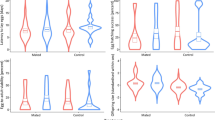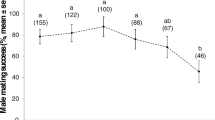Abstract
Male fertilisation success in relation to male size and the mating situation (ordinary pair formation with a single, nonvirgin female vs. take overs) was examined in the fly Dryomyza anilis. In ordinary matings, large males achieved higher fertilisation success than small ones when they were the second to mate with the female. Take overs differ from ordinary pair formation in that the second male experiences intensified sperm competition. This is because in take overs the female is not able to discharge any of the sperm inseminated by the first male as she usually does before a new mating. Compared with ordinary matings, take overs reduced the fertilisation success of the second male by 8–10%, whereas that of the first male was 7–14% higher in take overs. Even though the intruder was always larger than the paired male his superior fertilisation success did not compensate for the effect of the sperm already present in the female. In D. anilis, males can increase their fertilisation success by tapping the female's external genitalia with their claspers or having several copulation bouts per mating. Thus, in a take over, the intruder could respond to the intensified sperm competition by performing more tapping sequences per copulation bout or more copulation bouts per mating. In matings observed in the wild, males performed more tapping sequences after a take over than after pair formation with a single female, although the difference was not significant. The results show that there are differences in fertilisation success between males of different size. In addition, different mating situations can result in considerable variation in the fertilisation success of an individual male. Higher fertilisation success for the first male after a take over may be significant, in particular, for the reproductive success of small males, which frequently lose their females to large males.
Similar content being viewed by others
References
Baker RR, Bellis MA (1989) Number of sperm in human ejaculates varies in accordance with sperm competition theory. Anim Behav 37:867–869
Boorman E, Parker GA (1976) Sperm (ejaculate) competition in Drosophila melanogaster, and the reproductive value of female to males in relation to female age and mating status. Ecol Entomol 1:145–155
Dewsbury DA (1982) Ejaculate cost and male choice. Am Nat 119:601–610
Dewsbury DA (1984) Sperm competition in muroid rodents. In: Smith RL (ed) Sperm competition and the evolution of animal mating systems. Academic Press, Orlando, pp 547–572
Dickinson JL (1986) Prolonged mating in the milkweed leaf beetle Labidomera clivicollis clivicollis (Coleoptera: Chrysomelidae): a test of the ‘sperm-loading’ hypothesis. Behav Ecol Sociobiol 18:331–338
Eberhard WG (1985) Sexual selection and animal genitalia. Harvard University Press, Cambridge
Gage MJG (1991) Risk of sperm competition directly affects ejaculate size in the Mediterranean fruit fly. Anim Behav 42:1036–1037
Gage MJG, Baker RR (1991) Ejaculate size varies with socio-sexual situation in an insect. Ecol Entomol 16:331–337
Ginsberg JR, Huck UW (1989) Sperm competition in mammals. Trends Ecol Evol 4:74–79
Gromko MH, Gilbert DG, Richmond RC (1984) Sperm transfer and use in the multiple mating system of Drosophila. In: Smith RL (ed) Sperm competition and the evolution of animal mating systems. Academic Press, Orlando, pp 372–427
Lewis SM, Austad SN (1990) Sources of intraspecific variation in sperm precedence in red flour beetles. Am Nat 135:351–359
Otronen M (1984) Male contests for territories and females in the fly Dryomyza anilis. Anim Behav 32:981–998
Otronen M (1989) Female mating behaviour and multiple matings in the fly Dryomyza anilis. Behaviour 111:77–97
Otronen M (1990) Mating behaviour and sperm competition in the fly Dryomyza anilis. Behav Ecol Sociobiol 26:349–356
Otronen M (1993) Male distribution and interactions at female oviposition sites as factors affecting mating success in the fly Dryomyza anilis (Dryomyzidae). Evol Ecol 7:127–141
Otronen M (1994) Repeated copulations as a fertilization maximization strategy in the fly Dryomyza anilis (Dryomyzidae). Behav Ecol 5:51–56
Otronen M, Siva-Jothy MT (1991) The effect of postcopulatory male behaviour on ejaculate distribution within the female sperm storage organs of the fly Dryomyza anilis (Diptera: Dryomyzidae). Behav Ecol Sociobiol 29:33–37
Parker GA (1984) Sperm competition and the evolution of animal mating strategies. In: Smith RL (ed) Sperm competition and the evolution of animal mating systems. Academic Press, Orlando, pp 1–61
Parker GA (1990a) Sperm competition games: raffles and roles. Proc R Soc London B 242:120–126
Parker GA (1990b) Sperm competition games: sneaks and extrapair copulations. Proc R Soc London B 242:127–133
Ridley M (1989) The incidence of sperm competition in insects: four conjectures, one corroboration. Biological Journal of the Linnean Society 38:349–367
Rubenstein DJ (1989) Sperm competition in the water strider, Gerris remigis. Anim Behav 38:631–636
Simmons LW (1987) Sperm competition as a mechanism of female choice in the field cricket, Gryllus bimaculatus. Behav Ecol Sociobiol 21:197–202
Simmons LW, Parker GA (1992) Individual variation in sperm competition success of yellow dung flies, Scathophaga stercoraria. Evolution 46:366–375
Smith RL (1979) Repeated copulation and sperm precedence: paternity assurance for a male brooding water bug. Science 205:1029–1031
Turner ME, Anderson WW (1984) Sperm predominance among Drosophila pseudoobscura. Evolution 38:983–995
Walker WF (1980) Sperm utilization strategies in nonsocial insects. Am Nat 115:780–799
Ward PI (1993) Females influence sperm storage and use in the yellow dung fly Scathophaga stercoraria (L.). Behav Ecol Sociobiol 32:313–319
Author information
Authors and Affiliations
Rights and permissions
About this article
Cite this article
Otronen, M. Fertilisation success in the fly Dryomyza anilis (Dryomyzidae): effects of male size and the mating situation. Behav Ecol Sociobiol 35, 33–38 (1994). https://doi.org/10.1007/BF00167057
Received:
Accepted:
Issue Date:
DOI: https://doi.org/10.1007/BF00167057




